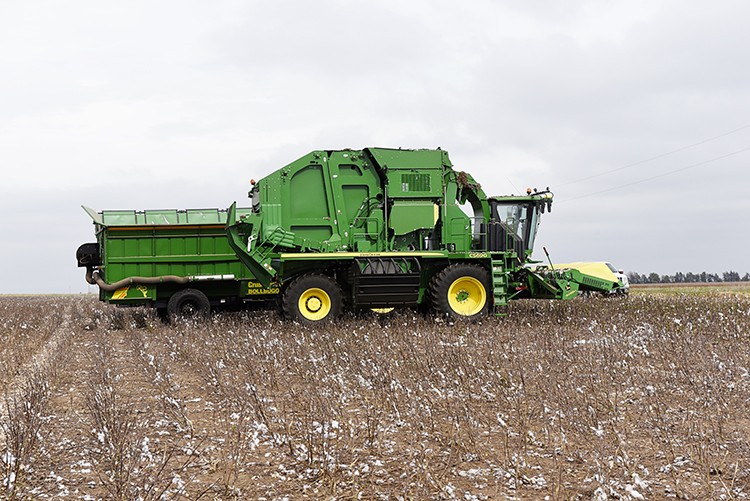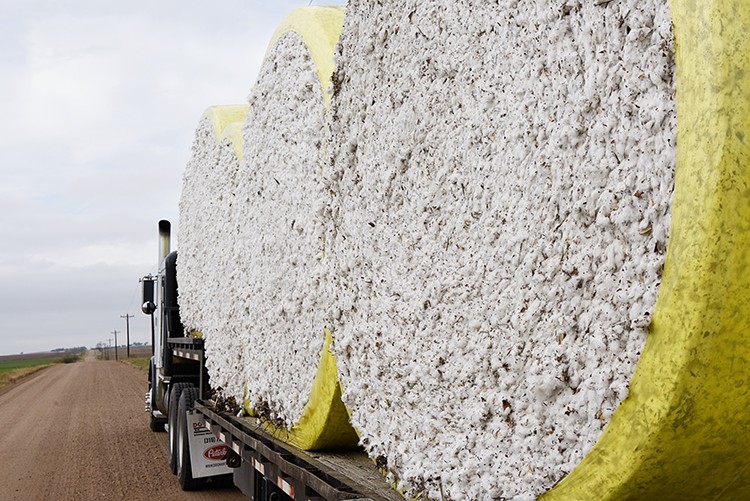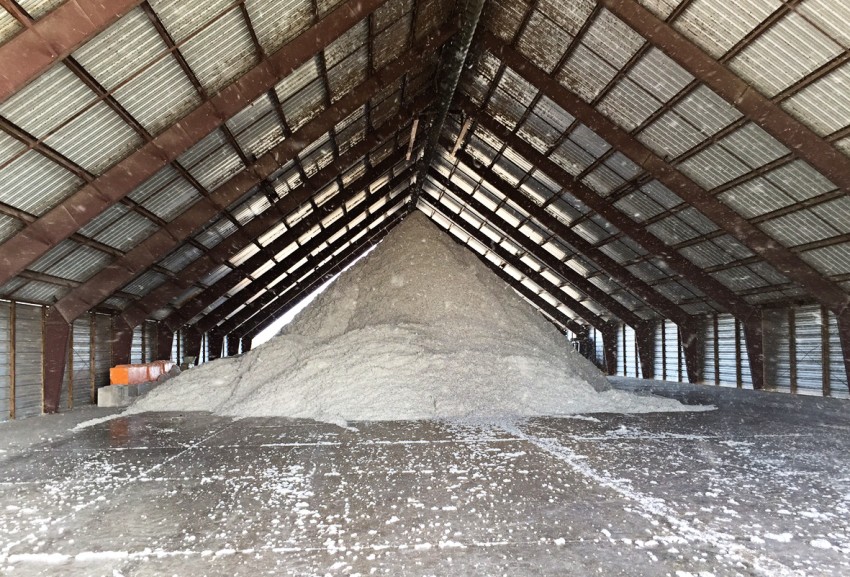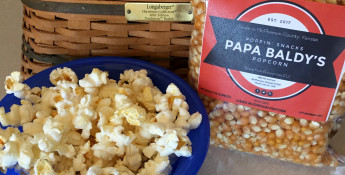By Rick McNary on November 21, 2016
Growing cotton in Kansas
Learn more about cotton harvest and the many uses of this crop
Kent Goyen smiles as he gazes over his field of snow-white cotton framed against a navy-blue sky. Like a proud parent cheering on a child crossing the finish line, he applauds the crop he loves.
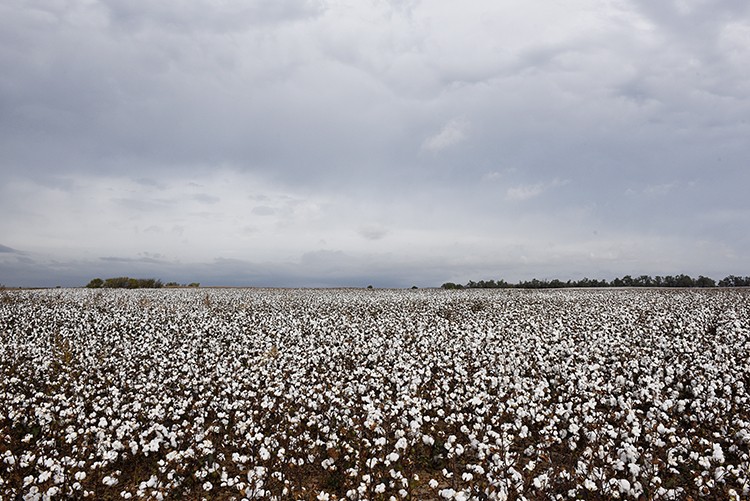 “When cotton first starts to grow in the spring, the plant stays small a long time and you don’t think it’s going to make it,” Kent says. “But it’s fascinating to watch it struggle through all the stages of growth. The prettiest stage is right before the fall harvest when it turns white.”
“When cotton first starts to grow in the spring, the plant stays small a long time and you don’t think it’s going to make it,” Kent says. “But it’s fascinating to watch it struggle through all the stages of growth. The prettiest stage is right before the fall harvest when it turns white.”
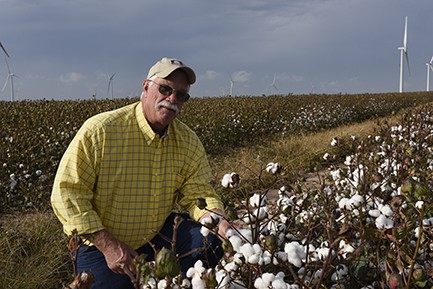 Kent, a third generation farmer near Pratt, is the president of the Kansas Cotton Association and the chairman for the American Cotton Producers in Kansas.
Kent, a third generation farmer near Pratt, is the president of the Kansas Cotton Association and the chairman for the American Cotton Producers in Kansas.
“One of the good things about cotton is it requires about half the water as other crops,” Kent says. “Water conservation is a major concern for farmers. Another benefit of cotton is it grows well in poor soil.”
The plant grows the seed and cotton inside a boll. The boll is closed until the plant matures, then slowly opens up. Once the plant is ready to harvest, the challenge is separating the cotton and the seeds from the bolls.
Unlike other crops that are harvested with a combine, a stripper is used to harvest cotton. The stripper uses a combination of brushes to remove the boll from the plant.
“People think walking in tall cotton is a good thing,” Kent says. “If you planted a cotton seed in a pot inside the house and let it grow, it would get nine feet tall. However, we prefer the cotton stays short so the stripper can grab it easier. As good as the stripper works, the cotton still ends up with a lot of trash in it. That’s where the cotton gin comes in to play.”
Once the cotton is stripped, it is dumped into a wagon called a buggy. The buggy dumps it into a portable stomper. The stomper tamps the cotton down and creates a module that looks like a loaf of bread. The module is covered with a tarp, loaded onto a truck then taken to the gin.
“John Deere makes a new stripper that rolls the cotton right into a round module on the machine,” Kent says. “That eliminates the buggy and stomper and the round modules are taken straight to the gin.”
One such cotton gin (short for engine) is located near Winfield. Dr. Rex Freeman, an expert in cotton production, represents the Plains Cotton Cooperative Association.
“Eli Whitney, considered to be the father of technology, patented the first gin in 1792 and it was a major force in the industrial revolution,” Rex says. “The gin begins by separating the raw cotton from the seeds. We end up with four products: seeds, motes, trash and lint. None of the cotton is wasted; even the trash is sold for compost.”
After Whitney’s gin went into operation, the U.S. became a major exporter of cotton. In 1793, the U.S. exported 500,000 pounds of cotton, yet 17 years later, they exported more than 93 million pounds a year. The negative side of the cotton gin was it prolonged slavery in the south.
The first step of ginning is to feed raw cotton into a large machine that dries it. Then it drops through a horizontal shaft lined with dozens of spinning saw blades spaced about a ½ inch apart so the seeds fall in between.
The blades rip the cotton away from the seed then run it through a series of machines designed to separate the boll husks, sticks and other trash. The finished cotton lint is then pressed into a 500-pound bale.
“Each bale has samples removed and bar-coded,” Rex says. “Those samples are sent to the USDA and graded for quality. The farmer receives his payment for the quality of the lint based on its length, thickness, color and cleanliness.”
The seeds fall through the saw blades into a trough that moves them to another building. Some gins send the seeds to a crushing plant. The oil is squeezed out, the remaining meal is pressed into pellets for livestock feed and the hulls are used in oilfields for well drilling. Other gins, like those in Kansas, send the high protein seeds straight to farms for dairy cows to eat.
“Another by-product is called motes,” Rex says. “Motes are a low-grade cotton used by the bedding and automotive industry for batting and everyday items like mops and Q-tips.”
Like all farmers, the price Kent receives for his crops fluctuate on circumstances beyond his control. China, the largest purchaser of cotton because of their textile mills, currently has enough cotton in storage to last 18 months. Excess cotton in China drives down prices in the U.S.
Another influence on the price of cotton is the price of oil. Since polyester is made from petroleum, when the price of oil goes down, so does the price of polyester —cottons biggest competition in the textile industry.
“Check the tag of your clothes to make sure you’re buying as much cotton content as possible,” Kent says. “The higher the cotton percentage, the better the clothing will feel. Most of the cotton grown in Kansas is the kind used for denim.”
Kansas cotton farmers, like Kent, are challenged with the contradictory principle that the better they perform, the less money they make. Wheat, for example, was a bumper crop this year yet the prices were too low for famers to cover their cost. There are few other professions where you produce your best work and receive less money.
“My grandpa told me when I was raising hogs to pay my way through college that I ought to find an easier way to make a living,” Kent says. “So I left the farm for 20 years, but I came back. I can’t think of anything else I’d rather do than to plant a cotton seed, help it grow and watch it cover a field like snow.”


